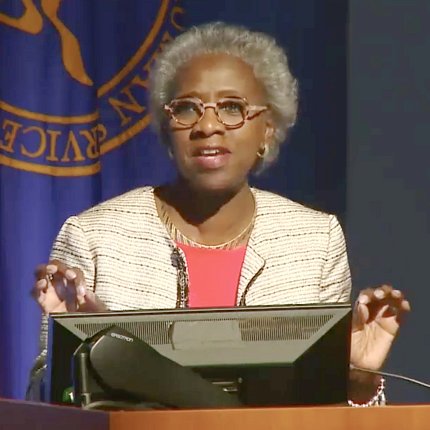Meeting Offers Updates on IRP, Security Policies

Members of NIH’s leadership outlined a new policy that will place term limits on intramural laboratory and branch chiefs and discussed campus security policies at the Assembly of Scientists annual town hall meeting in Masur Auditorium on May 21.
“There’s a real issue at NIH in terms of the representation of women and certain minority groups among our leadership—that is, our laboratory and branch chiefs,” said NIH deputy director for intramural research Dr. Michael Gottesman.
To create new opportunities for women and minorities, and to bring new ideas and approaches to scientific leadership at NIH, the NIH equity committee worked with the scientific directors and institute and center leadership to develop a draft policy. Once details are worked out, Gottesman said it will require that:
- IC leadership define the [lab or branch chief] position’s duties and expectations
- Each IC’s board of scientific counselors evaluate the effectiveness of all lab and branch chiefs
- By the current plan, appointments are limited to three full positive review cycles
- The search process for open positions is transparent.
He added it is possible appointments might be extended in cases where the science would suffer because of a leadership change or if there isn’t a qualified applicant pool.
“There are ongoing discussions on how to implement this policy,” Gottesman said. “The intent is to be fair and even-handed.”
Maintaining Workforce Diversity

Recruiting and retaining a diverse workforce is vital to improving the health of our nation, said Dr. Hannah Valantine, NIH’s chief officer for scientific workforce diversity.
Many students leave the field of biomedical research during the transition from trainee to tenure-track positions, she said. In NIH’s intramural program, women hold 24 percent of tenured positions and 42 percent of tenure-track positions. African Americans hold 1.2 percent of the tenured positions and 4.7 percent of tenure-track positions.
Valantine’s office has developed the NIH Scientific Workforce Diversity Toolkit, which includes information on how to find and recruit qualified candidates from diverse backgrounds, training on implicit bias and information on mentoring.
“We must provide the tools to help people identify candidates and train people,” she explained.
Valantine’s office is also studying the impact of sexual harassment at NIH. To determine the agency’s culture, NIH conducted the Workplace Climate and Harassment Survey, an in-depth, scientifically rigorous assessment of the NIH workplace. The survey’s results were released in an interim report to the advisory committee to the NIH director at its June meeting (see story).

“The most important outcome of the survey is that we will be working on new efforts to eliminate these experiences that are so pervasive around us,” she said.
To ensure that junior investigators have every opportunity to succeed in a collegial and diverse environment, mentoring and professional development courses must be integral parts of NIH, said Dr. Carl Hashimoto, senior advisor for faculty development.
At NIH, there are three sources of mentoring, with each having complementary strengths, he said. Individual mentors provide specific scientific advice. Mentoring committees provide perspective and feedback on tenure progress. Informal discussion groups provide peer mentoring and social support.
“If we can ensure these sources of mentoring for everyone, then I think we encourage individuals from diverse backgrounds to succeed,” he said.
For the first time, Hashimoto helped organize a monthly professional development curriculum for tenure-track investigators and assistant clinical investigators.
“They cover topics that are of interest and relevant to anyone leading an interest group,” he explained. Workshop topics include resilience and emotional intelligence, negotiation and conflict management.
Policy on Visitors
Recently, a graduate student from a country declared as a state sponsor of terrorism by the Department of State was on campus to apply for a postdoctoral position. He was interrupted during his scientific presentation and escorted off NIH’s campus.
In an NIH-wide email, NIH director Dr. Francis Collins said he was “deeply troubled” by the incident and “extended a personal apology” to the individual.
Every campus visitor, U.S. citizen or non-U.S. citizen, must be screened, said Bill Cullen, NIH chief security officer. He likened the process to going through TSA security screening at airports.

Since 2011, Cullen said, an HHS policy has required foreign nationals from four countries declared as state sponsors of terrorism to fill out a foreign visitor data request form at least 10 days before their visit.
Once cleared, the person who filled out the form must be escorted while on NIH property. The clearance is good for one year.
Currently, NIH is developing materials to educate staffers on the steps they must take if they are going to invite visitors from the four countries.
The Council of the NIH Assembly of Scientists is an elected committee representing its constituents (tenured and tenure-track investigators, staff clinicians and staff scientists, including intramural and extramural NIH employees) to the NIH leadership.
NIH’ers can watch the entire meeting online at https://videocast.nih.gov/summary.asp?Live=32040&bhcp=1.
